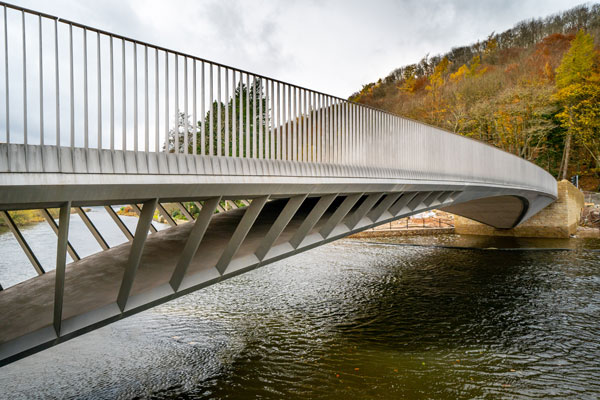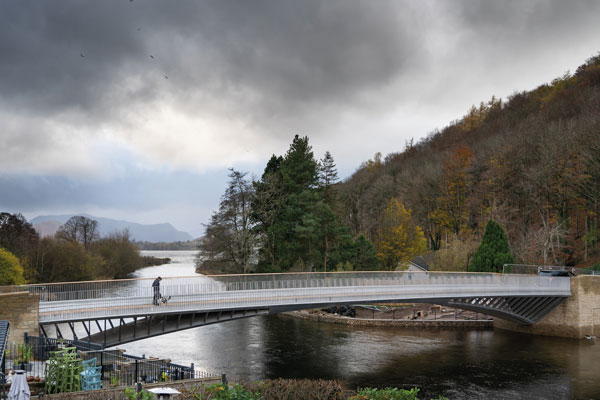SSDA Awards
AWARD: Pooley New Bridge

Spanning the River Eamont and replacing a crossing damaged by floods in 2015, a new sustainably-designed composite stainless steel bridge pays homage to its predecessor.
FACT FILE
Architect: Knight Architects
Structural engineer: GHD
Main contractor: Eric Wright Civil Engineering
Client: Cumbria County Council
The Cumbrian village of Pooley Bridge has provided an important crossing over the River Eamont for more than 250 years, through its Grade-II listed three-span stone arch bridge, built in 1764.
Unfortunately, daily life in the village and the surrounding region was severely disrupted when the historic crossing collapsed in 2015, due to flooding caused by storm Desmond.
The shock of its abrupt removal was partially relieved by the installation of a temporary bridge three months later that helped motorists avoid a 16km detour, but its ongoing presence was said to be a daily reminder of loss and vulnerability.
A new crossing was deemed necessary and bridge specialists Knight Architects was appointed by Cumbria County Council (CCC) in mid-2017, after a tender process, for the concept design of a new structure. The objective was to conceive a flood-resilient and future-proof bridge, complying with the current technical standards and the Environment Agency (EA) regulations, and supported by the community.
According to the architects, the exceptional and meaningful engagement process involved listening to the community and focusing on their common desire to conceive a unanimously supported design that met their aspiration for a high-quality new crossing.
The new bridge is said to be a unique and exceptionally slender 40m-span open-spandrel arch with an innovative composite stainless steel and high strength concrete structure that emerges from local sandstone-clad reinforced concrete abutments. The single clear span minimises environmental impact and flood risk.

Importantly, the new bridge pays homage to its predecessor and other examples of British bridge heritage. It also looks to the future, becoming a fitting addition to the site thanks to its lightness and transparency, not only providing unhindered views, but minimising obstruction to water in flood events.
The bridge is said to be the first stainless steel road bridge in the UK. Consequently, it is unique in terms of materials used, how they are combined, and the structural layout. Notably, the bridge has 7.5m-long hidden back-spans within the abutments to transfer the horizontal component of the arch compression to the deck. This provides a traditional deck-arch appearance, but without transferring horizontal reactions to low-capacity ground (variable glacial till that discouraged piling).
Other innovative solutions used in the design and construction included a movement joint system that allowed movements in three different directions, casting Converge sensors in the concrete for monitoring strength gain (a critical parameter before lifting), and laser scanning of the steelwork after site assembly, which made sure it would fit perfectly within the existing tight tolerances.
According to the project team, the use of lean duplex stainless steel made it possible to deliver a bridge that looks contemporary, will age naturally like the previous historic bridge, has excellent durability without the need for maintenance and has about 25% more structural capacity than a conventional steel bridge. Stainless steel has also allowed the bridge to be lighter, both for construction and in terms of slenderness. The choice of material was also based on whole life cost, having been considered by the client as a cost-effective solution when taking maintenance savings into account.
The slender design, made possible by the high strength stainless steel, minimised the amount of material used and its associated embodied CO2 content. The specific type of steel used has one-fifth of the embodied carbon of the global average of stainless steel, due to its 85% recycled content and the low-carbon energy at production sites.
When it came to the construction programme, a number of challenges had to be overcome. The construction of the bridge was constrained by environmental and economic aspects as the work had to happen outside of the salmon spawning season to fulfil the EA requirements, but without interfering with the tourist season and local businesses.
These issues left a very short window for the onsite works and encouraged maximising offsite construction. Using steel as part of the structure was fundamental to achieving these requirements. The 110t of steelwork, all made up of bespoke sections, was fabricated in four quarters, taking approximately 22,000-man hours to complete.
To assist with the steel erection, a jig was created on site to mount the steel sections, allowing work to be completed simultaneously throughout different areas of the structure. A total of 1,920 shear studs were machined from stainless steel bars and welded to the inner surfaces of arch and deck to form the steel-concrete composite connection.
The steelwork was then subject to a grinding and bead-blasting process that achieved a smooth homogeneous matt finish which faded the welds, preventing organic matter accumulation on the surface and making it possible for the bridge to blend with the natural setting. The bridge steelwork was then assembled onsite, using a temporary support structure positioned on the riverbank.
Subsequently, the concrete part of the arch was cast and then the stainless steel part of the deck welded before installing this partially-complete structure in a single lift.
After the lift, the back-spans were installed inside the abutments, the temporary ties linking the arch springings removed, and the concrete part of the deck poured to complete the permanent structural system.
Summing up, the judges say ingenuity, innovation and beauty combine in this remarkable replacement for the Grade-II listed stone bridge swept away by floods in 2015. The UK’s first structural stainless steel road bridge, the solution utilises expertly fabricated high strength low nickel alloys to achieve a low maintenance and highly efficient structure.









